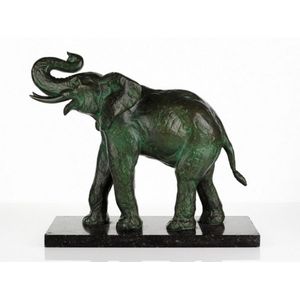Bronze Elephant and Sphinx Sculptures
You must be a subscriber, and be logged in to view price and dealer details.
Subscribe Now to view actual auction price for this item
When you subscribe, you have the option of setting the currency in which to display prices to $Au, $US, $NZ or Stg.
- Hollow Cast - Hollow casting is a metalworking process used to create hollow objects such as sculptures, jewelry, and other decorative objects. It involves casting metal in a mould that has a cavity in the shape of the desired object.
The process of hollow casting has been used for centuries, and its invention is not attributed to a single individual. However, ancient civilizations such as the Egyptians and Greeks used this process to create metal objects. In modern times, hollow casting has been used by artists, jewellers, and manufacturers to create a wide range of objects.
The first step in hollow casting is to create a model of the object to be cast from materials such as clay, wax, or metal, and from this a mould is created around it using a material such as plaster, silicone, or rubber. A core is created inside the mold to create the hollow cavity of the final object and then molten metal is poured into the mould, filling the space around the core. The metal is then allowed to cool and harden.
Once the metal has cooled and hardened, the core is removed from the mold, leaving a hollow object which is then finished by removing any excess metal or imperfections and polishing or texturing the surface as desired.
Hollow casting is used to create a wide variety of objects, including sculptures, jewellery, decorative objects, and parts for machinery. The process allows for the creation of complex shapes and details, and can be used with a wide range of metals, including bronze, brass, silver, and gold. Hollow casting is also used in manufacturing to create components such as engine blocks and machine parts. - Bronze - An alloy of copper and tin, traditionally in the proportions of about 9 parts of copper to 1 part of tin.
The discovery of bronze in Western Asia in the 4th century enabled people to create metal objects which were superior to those previoulsy possible because of its strength and hardness, and it has been used throughout the world for weapons, coins, tools, statuary and other decorative items.
It is very fluid in a molten state, and its hardness, strength when set, and non-corrosive properties makes it most suitable for casting sculpture.
This item has been included into following indexes:
Visually similar items

Attributed to Georges-Raoul Garreau, bronze elephant, French c. 1920 mounted on rectangular marble base, signed to foot 'G. Garreau'. Height 43 cm, width 50 cm, depth 20 cm

Attributed to Georges-Raoul Garreau, bronze elephant, French c. 1920 mounted on rectangular marble base, signed to foot 'G. Garreau'. Height 43 cm width 50 cm depth 20 cm

An Art Deco spelter panther, circa 1920s-30s, the green patinated figure of a prowling panther upon a veined cream marble plinth faced with alternate rouge and cream crackle marble, height 19 cm width 55 cm depth 16 cm

Avo Tiedman African Elephant, Bronze, 38 cm high
